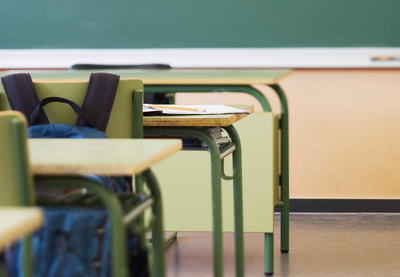After pushing a resource cart around for over two years, this spring I was elated to welcome my students to my very own classroom. I no longer had to fill my backpack with papers to haul from class to class, wrangle a cart through crowded hallways or speed walk back to the office to fetch forgotten materials.
My classroom is brand new and is located at the very end of a long hallway, far from the rest of the world language department and almost everything else in the school. In fact, when the science department created a scaled model of our solar system within the building, Pluto was right outside my new classroom door.
I spent an afternoon eagerly arranging desks and hanging posters, maps, flags and student work on the walls. I filled my cabinet with supplies and made a welcome slide to project onto the screen at the beginning of class on the first day in our new room. I knew that my students would have to walk twice as far as they did before to get to the new room, so I wanted to create a learning environment that would make it worth it for them.
As I looked around one last time before locking up, I was excited to welcome my students to my new classroom. It was colorful and inviting, and I hoped that the mixture of student work and Spanish posters on the walls would make it a place where my students would feel comfortable, valued and ready to learn.
It was fifth hour the next day when I overheard a conversation between two of my students. I couldn’t make out Jerome’s first comment, but when Davis responded, I didn’t miss a word.
“Yeah,” he agreed. “If the shooter was way down there, he’d have a straight shot at us. We’re a sitting target.” Davis gestured toward the windows that framed the doorway in front of him, pointing to the long corridor on the other side. From where Davis and Jerome sat, they had a perfect view all the way to the gym at the end of hallway.
I took a breath as I glanced through the windows and down the lengthy hall and thought back to my third-hour class when I heard the students in the seats now occupied by Davis and Jerome have the same conversation.
I had not even taught a full day in the brand-new room, and twice already my students had commented on a shooter’s ability to injure or kill them from down the hallway.
We’re a sitting target.
In 2018, on the first day of learning in a new classroom environment, these are the thoughts that come to mind for high school students. Processing their exposure to a hypothetical shooter is part of how they acclimate to a new space.
It’s sad that they do this—but they’re not wrong. I can promise my students that I will do everything in my power to protect them and that our district is committed to their safety. I can attend professional development sessions that train me on how to respond in crisis situations. I can assure my students that our local first responders are dedicated professionals and trained to protect them.
But what about Santa Fe?
But what about Parkland?
But what about Virginia Tech?
But what about Sandy Hook?
And what about the other schools that have had shootings since 1999? Schools that were on the news for a night, students that were on the receiving end of the thoughts and prayers of the nation for a week…what about them? Beyond their traumatized students and community, few even remember which schools these are.
Every time a school shooting happens, we send thoughts and prayers and discuss solutions. More guns? Fewer guns? More security? Clear backpacks? Metal detectors? More code-red drills? And then the discussions fade until the next tragedy occurs and we argue with renewed zeal. In the meantime, every day, our students are walking into classrooms trying to focus on their education amidst valid concerns about their safety and hoping that they don’t make the news. Because until things change, they are still in danger. And they know that.
Hear this teacher’s plea:
May we not grow comfortable with the repeated thoughts and prayers. May we not consent to this new normal. May we not be forced to consider sightlines when setting up our classrooms. May we fight for our students to be free to learn without fear.
Berridge teaches Spanish at Thornton Fractional South High School in Lansing, Illinois.
